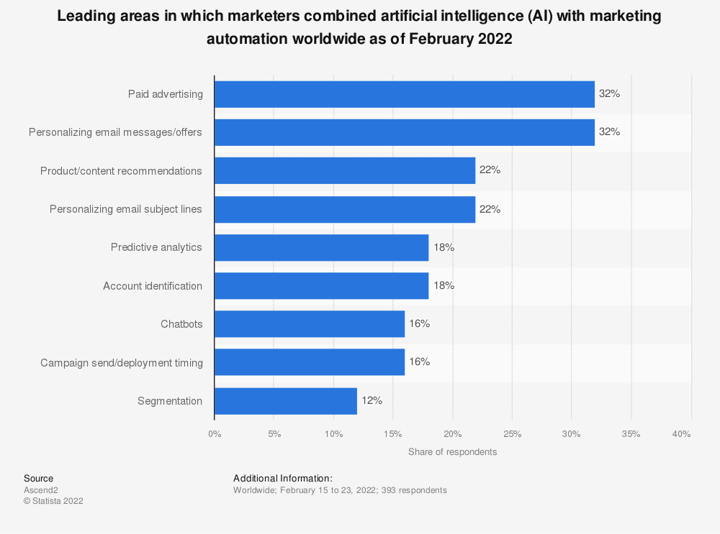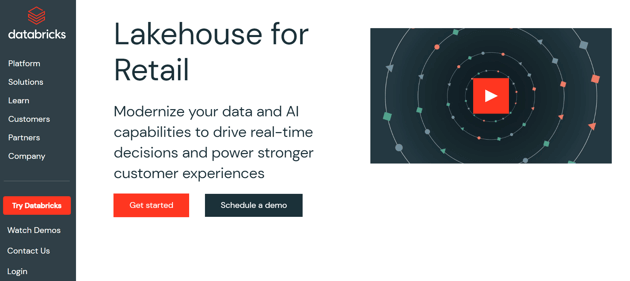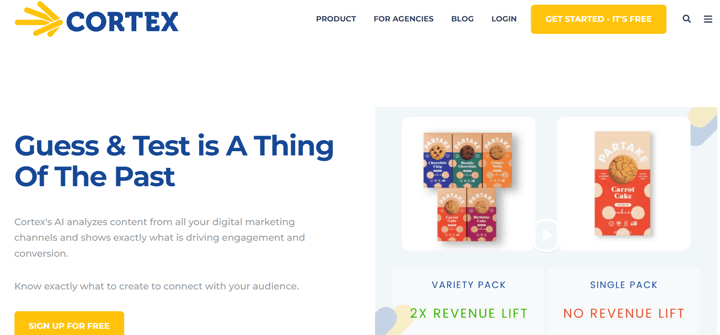What Should Your E‑Commerce Homepage Look Like? Tips & Examples
Your homepage has a few seconds to make or break a sale. Learn the essential homepage best practices that build trust and turn visitors into customers.

Predictive marketing can be a great tool in today's digital age. Consumer preferences and expectations are constantly changing. Therefore, online businesses need to stay up to date with all the new information at their disposal in order to improve the shopping experience and increase sales. In this article, we will talk about predictive marketing, a strategy that will help you achieve just that.
Table of contents
Predictive marketing is an automated marketing strategy that detects patterns in consumer shopping behaviour in order to anticipate consumer preferences. It is based on the extraction of data found in Big Data.
In other words: big data is used to produce accurate forecasts of future audience behaviour.
In order to identify and gather relevant data, data mining techniques are used.
After carrying out an exhaustive review of user interactions with the respective server, patterns are found and used to help forecast the behavior that a customer will have when making a purchase.
To do so, businesses and marketers analyse attributes such as the purchase history, the navigation of searches performed on or off the website, or an overall analysis of the online shop and customer behaviour is carried out.
Thanks to predictive marketing, businesses will be able to predict future consumer behaviour, improve their websites, optimise the customer journey, and plan future marketing activities more easily.
Lately, with the surge in artificial intelligence (AI) technologies, it’s easier than ever to automatically gather and evaluate data.
But why do that?
According to a study conducted by Accenture, 91% of users prefer to shop with brands that they recognise, remember and provide them with personalised offers and recommendations relevant to their tastes.
💡Speaking of artificial intelligence:
If your customers and potential future customers feel that they are being heard and understood by your brand thanks to your optimisations, they will naturally want to come back to your online shop and shop again with your brand.
This marketing strategy will therefore also help you to capture the attention of past customers and win them back.
Recommended Reading:
What Kind of Loyalty and Rewards Systems Work for Small Businesses?
When talking about the so-called customer lifetime value (CLV in short), we refer to the total value of revenue that a single customer generates for your business throughout the entire time of the business relationship.
As all your target audience’s expectations and desires are met, you will turn into their preferred brand, meaning they will come to you to make their most important purchases.
This will then lead to more profits for your business.
Running an online shop or online business, you’re surely aware that just because a user visits your website doesn’t necessarily mean that they will in fact buy something.
Even more so, the chances of customers leaving your website without purchasing an item are higher if they don’t find what they were looking for. In such cases, a high bounce rate for your online shop is more likely.
Using the data you gathered to improve the customer journey, for example, by optimising the search bar, would then help your customers to find desired products or lists of items that really interest them in a more intuitive and simpler way when browsing your website.
In doing so, you will increase your conversion rates and sell more of your products.
Thanks to automated predictive analytics, your company will receive more accurate and segmented information on your customers.
Apart from the other advantages listed, you can also use this kind of information to provide more personalised recommendations of complementary products (cross-selling) or upgrades for purchases (upselling) for your customers (e.g. at the bottom of your product pages or in your newsletters).
The more your offers accurately match your audience's preferences, the more likely you are to successfully sell more.

"I predict a long trip in your future... so a 2nd set of batteries for your new camera might be useful!" (Shutterstock/nikkytok)
Recommended Reading:
Increase Sales through Upselling and Cross‑selling
Another advantage of the implementation of predictive marketing is that you will able to create better, more personalised ads, for example when using Facebook Ads or Google Ads.
This will allow you to target your audience better, meaning your ads are more likely to be displayed to those who are more likely to purchase in your online shop since your products and brand are actually related to their interests.

Source: shutterstock.com/Tartila
One of the biggest advantages of implementing this marketing strategy is the ability to prepare for changes in the market or the consumers themselves.
Since this strategy anticipates trends, it will certainly help you plan future marketing campaigns knowing that they are likely to be more successful.
Recommended Reading:
8 Ways to Build a Marketing Calendar
All in all, as you now know, using predictive marketing can bring quite some benefits to you and your business.
Creating a more personalised customer journey will not only decrease the time between entrance and checkout, but it will also boost satisfaction among your customers.
Now that you’re aware of the benefits of this marketing technique, you surely want to find out how to actually implement it...
So far, we have seen that predictive marketing is a crucial strategy to grow your online business.
The chart below shows the results of a study conducted by Ascend2, visualising the state of marketing automation in 2022.

Source: Statista
18% of business owners have already been using predictive analytics as an automated marketing method in 2022.
However, in order for you to successfully use it for your business, there are a couple of things that you will have to consider.
First of all, you need to think about the goal(s) you want to achieve.
What is it that you wish to accomplish when implementing predictive marketing?
What is your overall goal?
Another thing you need to consider is the data you will base all your analysis and future marketing activities on. This takes us right to the next step.
We recommend you use artificial intelligence tools to search for and extract data from Big Data.
This is the most efficient and convenient way to go.
Once the data has been collected, it needs to be processed and classified.
This will ensure you are left with only the most relevant information for your business and your industry.
Once the data processing tool is done and you have your data, you will need to take a closer look at it.
Make sure to profoundly analyse the information and trends that are now at your disposal.
With the results of the analysis, you will now be able to create predictive prototypes or scenarios.
Later, you can use them as a basis for your next marketing activities.
Recommended Reading:
Inbound Marketing: How to Turn Your Site’s Visitors into Customers
With the help of Google and Facebook Ads, you can recommend your products and/or services to more users who are genuinely interested in your offer and therefore increase the likelihood of purchase.
With a better understanding of your audience and their online behaviour, you can make more out of your marketing budget.
Many online shops have a recommendation section displayed on their website. Usually, it is integrated to the homepage, on product pages, or as pop-ups.
By integrating a small, more targeted recommendation section to your website, you’ll be able to offer potential customers products that they might like, or might like in addition to other products already in their shopping cart.
Product recommendations are thereby shown based on past purchases or complementary products such as an accessory that matches or might go well with the products that the users have already viewed.
Email and newsletters are channels that can really benefit from predictive marketing.
If a user is registered on your website, you could send them personalised emails with recommendations of products they might like, for example.
Keep in mind: when using email communication in terms of predictive marketing, it is essential to analyse the results after.
This way, you’ll be able to tell what worked particularly well and what didn’t in order to identify what needs to be optimised to achieve the best possible results.
There are various tools out there that are particularly helpful when it comes to carrying out data processing and analysis.
Some are these tools are based on artificial intelligence technology. They use algorithms to profoundly analyse customer and user data.
Now, we’ll introduce four useful tools that you can turn to once you’ve decided to implement predictive marketing into your business.
RapidMiner is a predictive analysis tool that is used to search for important data of your company such as trends or hidden patterns.
In order to forecast customer preferences, this data can then be used to create marketing activities.
The price for the tool varies, depending on the services that your company needs. Rapidminer offers a free demo, allowing you to try their features and services without being charged first.if u wa
DataBricks is a platform that supports businesses with the analysing, structuring, and processing of data by using machine learning technologies.
DataBricks offers a free trial for 14 days.

Source: DataBricks.com
Another helpful tool that we can recommend is Cortex.
It uses data analysis to detect current or future threats that might possibly harm your business.
Cortex is completely free of charge!

Source: meetcortex.com
With this tool, you can discover and identify potential customers.
Also, 6sense helps to predict the future shopping trends and preferences of your target audience.
6sense also offers a free demo for testing.
Many companies, both large and small, already use predictive marketing as a strategy to improve their sales.
One of the most cited examples, due to its expertise and unrivalled recommendation systems, is Amazon.
The application's algorithms analyse users' purchase and search histories, and the combination of items they have in their cart. The algorithm also compares the pattern of one user with those of other ones to identify similar behaviour in order to make more accurate suggestions.
Whenever a customer makes a purchase or only spends a few minutes looking at a specific product, this is being taking into account by the Amazon algorithm.
Predictive marketing has become an important strategy for online businesses.
Technologies used to carry out this process will continue to evolve, helping you to analyse your data in the best possible and rewarding ways. However, predictive marketing can already bring many benefits to your business.
Once you want to get started with this strategy, make sure to choose a tool that best suits your business, start gathering data, and carefully analyse the data you find.
This article was originally published on our Spanish Trusted Shops blog: Marketing predictivo: qué es y cómo aplicarlo
03/05/23Your homepage has a few seconds to make or break a sale. Learn the essential homepage best practices that build trust and turn visitors into customers.
Product reviews can have a big impact on your online shop. Whether it's conversions, building trust, or SEO, learn why your shop needs product reviews.